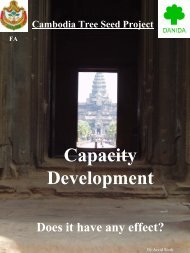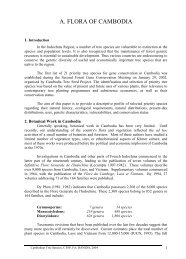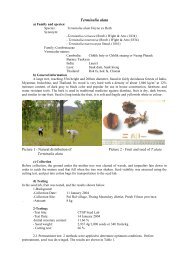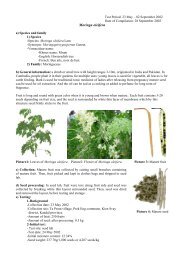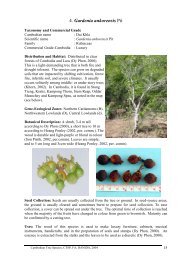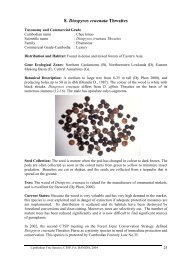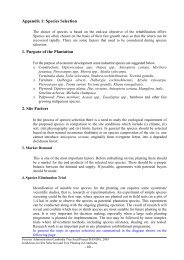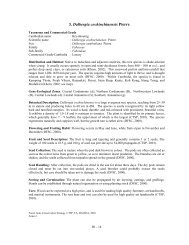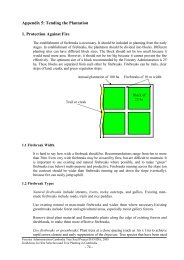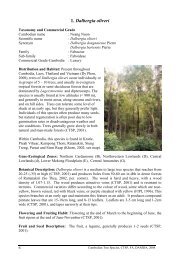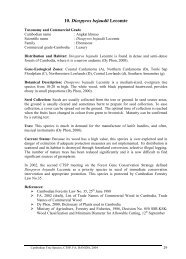Cambodia Forest Gene Conservation Case Study Part II
Cambodia Forest Gene Conservation Case Study Part II
Cambodia Forest Gene Conservation Case Study Part II
You also want an ePaper? Increase the reach of your titles
YUMPU automatically turns print PDFs into web optimized ePapers that Google loves.
habitats of the populations. Ex-situ is a more expensive approach, sometimes necessary in the case<br />
of rapid forest loss and degradation. Ex-situ activities generally complement in-situ conservation.<br />
The working group decided, based on an analysis of pros and cons, that in-situ conservation should<br />
be the primary conservation method, supported by ex-situ conservation when needed.<br />
Within the natural forests of <strong>Cambodia</strong>, in-situ conservation is the preferred<br />
option, to be complemented, in some circumstances, by ex-situ conservation.<br />
4.4 Identification of the <strong>Conservation</strong> Stands<br />
The number of stands to be conserved and their geographical distribution are identified through a<br />
comparison of gene ecological zones with the species conservation status. The identification<br />
process may follow the principles below (DFSC, 1997).<br />
1. Overlay the gene ecological zones with:<br />
• Past and present geographical distribution of the species<br />
• Occurrence of the species in ongoing planting programmes and protected areas<br />
• Location of provenances/populations of proven value<br />
2. Consider factors affecting genetic variation, conservation status, and the<br />
conservation investment requirements:<br />
• Type of distribution area<br />
• Reproduction and dispersal biology<br />
• Differences between past and present distribution<br />
• Size and geographical location of past and ongoing planting programmes, and<br />
origin of the planting material used<br />
• Possible effects of selective logging/felling in each zone<br />
• Occurrence of populations in protected areas<br />
• Degree of threats<br />
• Land tenure and associated options and costs<br />
3. Decide on appropriate geographical distribution and number of areas per zone to be<br />
sampled for conservation of genetic resources of selected species.<br />
The number of populations selected for conservation in each zone should generally be higher for<br />
out breeding species with scattered distribution, insect pollination, and limited seed dispersal,<br />
assuming larger genetic variation between populations than for species with continuous distribution,<br />
wind pollination and wide seed dispersal. Factors to consider in stand selection include<br />
(FAO/IPGRI/DFSC, 2004):<br />
• Abundance of target species and presence of key associated species<br />
• Low level of risk/threats (including secure land tenure)<br />
• Committed and adequately staffed management agency<br />
• Support from local people, owners and users of the area<br />
• Compact shape of area and presence of forest buffer zone<br />
• Possible opportunities to conserve other priority species<br />
• A minimum of 2 stands in each gene ecological zone.<br />
10



